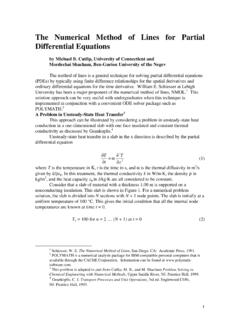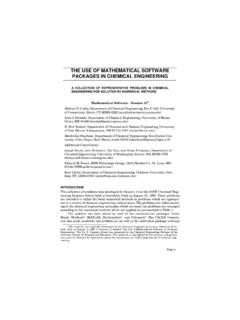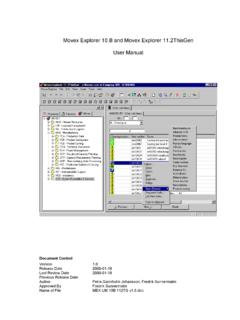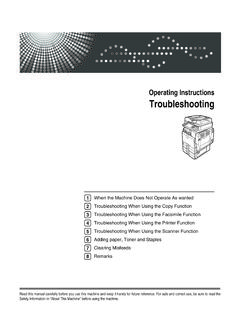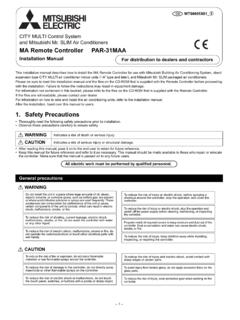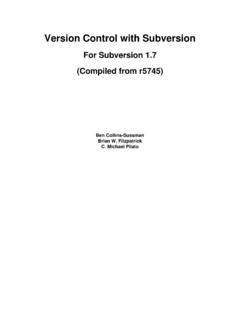Transcription of 4.1 Manual 0A 5 - Polymath Main Page Text
1 VERSION Provides System Printing from windows , 95, 98 and NTUSER-FRIENDLYNUMERICAL ANALYSISPROGRAMSPOLYMATH- SIMULTANEOUS DIFFERENTIAL EQUATIONS- SIMULTANEOUS ALGEBRAIC EQUATIONS- SIMULTANEOUS LINEAR EQUATIONS- POLYNOMIAL, MULTIPLE LINEAR AND NONLINEAR REGRESSIONfor IBM and Compatible Personal ComputersInternet: are encouraged to obtain the latest general informa-tion on Polymath and its use from the above Internet will include updates on this version and availability offuture B. Cutlip and Mordechai Shacham, the authors ofPOLYMATH, have published a new book entitled ProblemSolving in Chemical Engineering with Numerical book is a companion book for students and professionalengineers who want to utilize the Polymath software toeffectively and efficiently obtain solutions to realistic and com-plex problems.
2 Details on this Prentice Hall book, ISBN 0-13-862566-2, can be found on the preceding Polymath wwwsite or at and PC-DOS are trademark of International Business MachinesMS-DOS and windows are trademarks of Microsoft Corporationi -2 PREFACEPOLYMATH PCCopyright 1998 by M. Shacham and M. B. CutlipThis Manual may be reproduced for educational purposes by LICENSE AGREEMENTThe authors of Polymath and the CACHE Corporation agree to licensethe Polymath materials to the owner of this for noncommercial andeducational uses exclusively. Only one copy of this software is to be in useon only one computer or computer terminal at any one time.
3 One copy of themanual may be reproduced in hard copy only for noncommercial educa-tional individual-use license is for Polymath Version and applies to theowner of this software. Permission to otherwise copy, distribute, modify orotherwise create derivative works of this software is prohibited. Internetdistribution is not allowed under any software is provided AS IS, WITHOUT REPRESENTATION AS TOITS FITNESS FOR AND PURPOSE, AND WITHOUT WARRANTY OFANY KIND, EITHEREXPRESS OR IMPLIED, including with limitationthe implied warranties of merchantability and fitness for a particularpurpose.
4 The authors of Polymath shall not be liable for any damages,including special, indirect, incidental, or consequential damages, withrespect to any claim arising out of or in connection with the use of thesoftware even if users have not been or are hereafter advised of thepossibility of such REQUIREMENTS Polymath runs on the IBM Personal Computer and most com-patibles. A floating-point processor is required. Most graphics boards areautomatically supported. The minimum desirable application memory is450 Kb plus extended memory for large applications.
5 Polymath workswith PC and MS DOS and above. It can also execute as a DOSapplication under windows , windows 95, windows 98, and WindowsNT. It is important to give Polymath as much of the basic 640 Kbmemory as possible and up to 2048 Kb of extended memory duringinstallation. This version of POLMATH supports only the Windowsprinters that are available to your operating PCPREFACE i-3 TABLE OF CONTENTS - POLYMATHPAGE INTRODUCTIONPOLYMATH - 1 Manual - - 2 GETTING - - - 1 - 2 DISPLAY - 3 KEYBOARD - 3 ENTERING VARIABLE - 4 ENTERING - 4 MATHEMATICAL - 5 MATHEMATICAL - 5 LOGICAL - 6 Polymath - 6 HARD - - 6 GETTING STARTEDHARDWARE - 1 Polymath SOFTWARE.
6 2 - 1 INSTALLATION TO INDIVIDUAL COMPUTERS & - 1 FIRST TIME EXECUTION OF - 2 EXITING Polymath - 3 HELPMAIN HELP - 1 ACCESSING HELP BEFORE PROBLEM - 2 ACCESSING HELP DURING PROBLEM - 2 CALCULATOR - 3 UNIT CONVERSION - 3 - 1 CALCULATOR - 1 AVAILABLE - 1 ASSIGNMENT - 3 CALCULATOR - 3 UNIT - 5 PREFIXES FOR - 5 UNIT CONVERSION - 6i-4 PREFACEPOLYMATH PCPROBLEM - 7 FILE - 7 LIBRARY - 8 LIBRARY - 8 LIBRARY - 8 PROBLEM OUTPUT AS PRINTED - 9 SAMPLE SCREEN - 9 OPTIONAL SCREEN - 1 0 PRESENTATION OUTPUT TO SCREEN AND AS PRINTED 4 - 1 0 PROBLEM OUTPUT AS DOS 4 - 1 1 PROBLEM OUTPUT AS GRAPHICS 4 - 1 1 DIFFERENTIAL EQUATIONS SOLVERQUICK 5 - 1 DIFFERENTIAL EQUATION - 1 STARTING - 1 SOLVING A SYSTEM OF DIFFERENTIAL - 2 ENTERING THE - 3 ALTERING THE - 4 ENTERING THE BOUNDARY - 4 SOLVING THE - 5 PLOTTING THE 5 - 6 EXITING OR RESTARTING - 7 INTEGRATION - 8 TROUBLE - 9 SPECIFIC ERROR - 9 NONSPECIFIC ERROR - 9 ALGEBRAIC EQUATIONS SOLVERQUICK 6 - 1
7 NONLINEAR ALGEBRAIC EQUATION - 1 STARTING - 1 SOLVING ONE NONLINEAR - 3 SOLVING A SYSTEM OF NONLINEAR - 5 EXITING OR RESTARTING - 7 SELECTION OF INITIAL ESTIMATES FOR THE UNKNOWNS6-7 METHOD OF - 7 TROUBLE - 8 Polymath PCPREFACE i-5 LINEAR EQUATIONS SOLVERQUICK 7 - 1 LINEAR EQUATION - 1 STARTING - 1 SOLVING FIVE SIMULTANEOUS - 3 EXITING OR RESTARTING - 4 REGRESSIONQUICK - 1 REGRESSION - 1 STARTING - 1 QUICK TOUR PROBLEM - 1 RECALLING SAMPLE PROBLEM ..8 - 2 FITTING A - 4 FITTING A CUBIC - 5 EVALUATION OF AN INTEGRAL WITH THE CUBIC - 6 MULTIPLE LINEAR - 7 RECALLING SAMPLE PROBLEM - 7 SOLVING SAMPLE PROBLEM - 8 TRANSFORMATION OF OR RESTARTING APPENDIXINSTALLATION AND EXECUTION 9 - 1 windows 9 - 1 windows 9 - 2 windows 9 - 2 USING PRINT METAFILES IN DOCUMENTS IN windows 9 - 2 windows 95, 98, AND NT 9 - 3 windows 95, 98, AND NT 9 - 3 windows 95, 98.
8 AND NT 9 - 3 USING PRINT METAFILES IN DOCUMENTS FOR windows 95, 98, AND 9 - 4 INSTALLATION - 4 ADDITIONAL NETWORK INSTALLATION 9 - 9 - 6"OUT OF ENVIRONMENT SPACE" 9 - 7i-6 PREFACEPOLYMATH PCINTRODUCTIONPOLYMATH is an effective yet easy to use computational systemwhich has been specifically created for professional or educational use. Thevarious programs in the Polymath series allow the user to apply effectivenumerical analysis techniques during interactive problem solving on apersonal computer. Whether you are student, engineer, mathematician,scientist, or anyone with a need to solve problems, you will appreciate theease in which Polymath allows you to obtain solutions.
9 Chances are verygood that you will seldom need to refer to this Manual beyond an initialreading because Polymath is so easy to Polymath , you are able to focus your attention on the problemat hand rather than spending your valuable time in learning how to use orreuse the program. You are encouraged to become familiar with themathematical concepts being utilized in Polymath . These are discussedin most textbooks concerned with numerical available programs in Polymath include:- SIMULTANEOUS DIFFERENTIAL EQUATION SOLVER- SIMULTANEOUS ALGEBRAIC EQUATION SOLVER- SIMULTANEOUS LINEAR EQUATION SOLVER- POLYNOMIAL, MULTIPLE LINEAR AND NONLINEAR REGRESSIONW hether you are a novice computer user or one with considerablecomputer experience, you will be able to make full use of the programs inPOLYMATH which allow numerical problems to be solved convenientlyand you have limited computer experience, it will be helpful for you to readthrough this Manual and try many of the QUICK TOUR problems.
10 If youhave considerable personal computer experience, you may only need to readthe chapters at the back of this Manual on the individual programs and trysome of the QUICK TOUR Manual will be a convenient reference guide when OVERVIEWPOLYMATH PCINTRODUCTION 1-1 Manual OVERVIEWThis Manual first provides general information on features which arecommon to all of the Polymath programs. Particular details of indi-vidual programs are then presented. Major chapter topics are outlinedbelow:INTRODUCTIONThe introduction gives an overview of the Polymath computa-tional system and gives general instructions for procedures to follow whenusing individual Polymath STARTEDThis chapter prepares you for executing Polymath the first time,with information about turning on the computer, loading Polymath , andmaking choices from the various menu and option access to a general help section is chapter discusses features that all programs have include a scientific calculator and a convenient conversion for unitsand dimensions.


